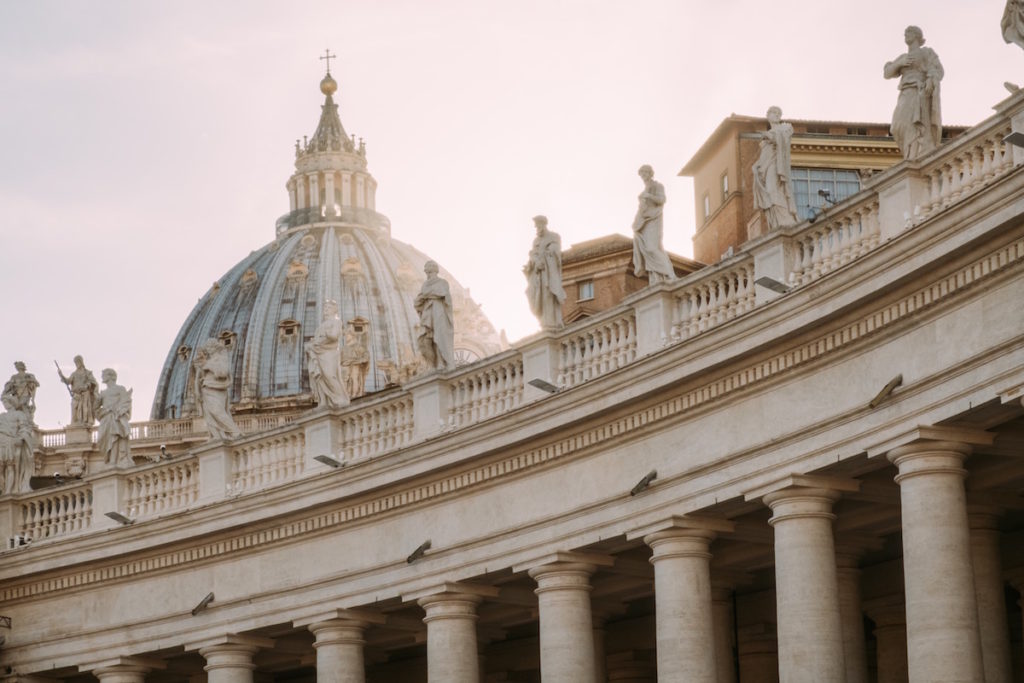This essay is part of our collection on the legitimacy of capital punishment. See the full collection here.
The Catechism of the Catholic Church will now define capital punishment as an “inadmissible . . . attack on the inviolability and dignity of the person,” thus bringing to a head a long-running debate within the Church. The contentious nature of that debate became especially apparent following two prominent interventions last year. The first was the publication of Edward Feser’s and Joseph Bessette’s thorough historical, theological, and philosophical defense of capital punishment, and their conclusion that its legitimacy, at least in principle, is a matter of irreformable doctrine. The second, coming fast on the heels of the first, was Pope Francis’s public assertion that the death penalty is “inhuman,” “contrary to the Gospel,” and therefore “inadmissible.” Unsurprisingly, an eruption of arguments and counter-arguments ensued in print and across the web. More will certainly be forthcoming.
Largely unremarked in the debate over capital punishment, however, are its striking parallels with the half-century-long, still unsettled, and also increasingly contentious intra-Catholic dispute concerning religious liberty. This is all the more curious because Pope Francis’s own remarks—now echoed in the language authorized for the Catechism—appear quite intentionally to echo important aspects of Dignitatis Humanae, the Second Vatican Council’s Declaration on Religious Freedom. According to that Declaration, for example, religious liberty is a right grounded in the “dignity of the human person.” As such, it is “inviolable.” This is precisely the language invoked by Pope Francis when he declared capital punishment impermissible because “it attacks the inviolability and the dignity of the person.”
Moreover, just as Dignitatis Humanae asserts that it “leaves untouched traditional Catholic doctrine,” while at the same time “developing” that doctrine, so too did Francis insist that his remarks in no way “signify a change of doctrine” or “any contradiction with past teaching”; they represent instead “the harmonious development of doctrine.” Both of these claims have proved controversial for the simple reason emphasized by Feser in the debate over capital punishment: “simply calling something a ‘development’ rather than a contradiction doesn’t make it so.” As he and Bessette argue, the Church’s earliest theologians acknowledged the legitimacy of capital punishment, in principle, and this conclusion was consistently affirmed by popes up through the twentieth century. The explicit rejection of that conclusion, they therefore reason, cannot logically be understood as a “development” of it.
Start your day with Public Discourse
Sign up and get our daily essays sent straight to your inbox.But precisely the same logic applies, mutatis mutandis, to the apparent claims of Dignitatis Humanae, since it deems religious liberty an inviolable right while also claiming not to have changed “traditional Catholic doctrine on the moral duty of men and societies toward the true religion and toward the one Church of Christ.” That traditional Catholic doctrine—as taught by the Church’s fathers, doctors, popes, and councils for more than a millennium—proclaimed it legitimate in both principle and practice to enforce that duty by means of coercion. Because Dignitatis Humanae appeared plainly to proscribe such coercion, however, it was not at all clear even to the bishops gathered at Vatican II how contradiction was actually being avoided. Indeed, just before the final vote on the Declaration, its official relator frankly admitted that “this matter will have to be fully clarified in future theological and historical studies.”
In the half century since, the various attempts at such clarification have fallen into paradigms that will be entirely familiar to those who have been following the debate on capital punishment. Some, such as Avery Dulles and Robert George, defend religious liberty as a development of doctrine made necessary by ambiguities in the previous centuries’ historically conditioned teaching. The formal teaching of the pre-Vatican II Church, acknowledged as doctrinal in nature, cannot be understood to have been erroneous; but an evolved understanding of its “deeper patrimony” now prevents the (mis)interpretations of that teaching that previously allowed the practice of religious coercion. Others, including Martin Rhonheimer and John Zmirak, defend religious liberty even while denying that it represents a development of doctrine. Instead, while granting that the Church did traditionally and explicitly—and wrongly—sanction coercion, they deny that such sanction ever attained the status of formal doctrine, and certainly not infallible doctrine. It was merely practical policy, always in principle subject to change, and now in fact changed by the teaching of Dignitatis Humanae.
With respect to capital punishment, these same two lines of argument have been advanced. Christopher Tollefsen and Paul Griffiths, for example, embrace a thesis of doctrinal development, while Christian Brugger denies that the Church’s long endorsement of capital punishment ever amounted to an actual doctrinal definition.
Given the very different means by which opponents of capital punishment attempt to harmonize their position with the Church’s traditional teaching, Feser is quite right to point out that those attempted harmonizations are incompatible even with one another. As is evident above, though, the same critique must apply to popular post-conciliar defenses of religious liberty. But the controversy about religious liberty is arguably even more confused than that concerning the death penalty, because on this topic even the defenders of the “traditional Catholic doctrine” differ among themselves about how—and whether—it might be harmonized with the teaching of Vatican II.
At one extreme are those such as the late Archbishop Marcel Lefebvre and the Society of Saint Pius X. Understanding the traditional teaching to be irreformable doctrine, and understanding Dignitatis Humanae to have contradicted that doctrine, they simply deem the latter heretical. Similarly, the announced change to the Catechism’s teaching on capital punishment has already prompted some to claim that Francis is in “open violation” of his papal authority. Even prior to those changes being authorized, Feser himself explicitly claimed that a pope who defined the death penalty as intrinsically immoral would be “manifestly guilty of doctrinal error.”
But Feser has also been clear that something like the status quo established during the last two pontificates remains entirely legitimate because, while effecting real change in thinking about the practical and prudential application of the death penalty, neither John Paul II nor Benedict XVI went so far as to define it as inadmissible in principle. Their pronouncements, therefore, can be logically harmonized with those of their predecessors through the previous millennia.
Something very much like this via media has also become increasingly popular among those made nervous by claims that Vatican II really did change or contradict the “traditional Catholic doctrine” concerning coercion in religious matters. While agreeing with Lefebvre and the SSPX that the traditional teaching is indeed irreformable, Thomas Storck, Brian Harrison, Thomas Pink, and others (as represented, for example, in this recent volume), have argued that Dignitatis Humanae neither contradicts nor even develops that doctrine. The principle allowing, for instance, legal prohibitions on publishing, proselytizing, and public worship by Protestants is indeed left “untouched” by Vatican II; what changed there was merely the answer to the question whether, given existing circumstances, the actual implementation of that principle is practical or prudential.
Quite obviously, given such disparate opinions, the controversy concerning the Church’s teaching on religious freedom is far from settled. But it differs from that concerning capital punishment because, as Feser himself notes, it is one that “most Catholics, including conservative Catholics, have avoided.” And he is surely correct in his understanding of the reason for this: “the older teaching is extremely unpopular in modern times, and thus whatever its current doctrinal status, most Catholics are happy to let it remain a dead letter and leave its precise relationship to Dignitatis Humanae unsettled.” And yet, he finally concludes, “a question unanswered and ignored is still a real question.”
Indeed, it is precisely the same question raised in the controversy over capital punishment: can a practice endorsed for more than a millennium by the Church’s fathers, doctors, popes, and councils now be condemned as an immoral and inadmissible violation of human dignity?
Feser has been repeatedly and consistently clear about what he perceives to be the implications of answering “yes” to this question—in the case of capital punishment. It would involve the Church in contradicting its own doctrine. It would implicate the Church in having taught “grave moral error” for more than a thousand years. It would nullify the Church’s claim to preserve intact the deposit of faith. It would confirm non-Catholic suspicions that traditional claims about the magisterium are a kind of “Orwellian sophistry.”
But since the fundamental question remains the same with respect to coercion in religion, the alternative horn of the dilemma presents itself clearly, and equally unattractively. By Feser’s own logic—and impressive it is—to answer “no” to the above question would necessarily, even if implicitly, be to endorse the legitimacy, in principle, of the “extremely unpopular” exercise of religious coercion.
This undoubtedly helps to explain why, despite the vast amount of ink spilled in the current controversy over capital punishment, there’s been a real hesitancy to make explicit its analogy with the longer-running and arguably more important debate respecting the Church’s teaching on religious liberty. But to revise Feser himself, an unsavory implication unanswered and ignored is still a real, and unsavory, implication.













